RIDGID TS3650 User Manual
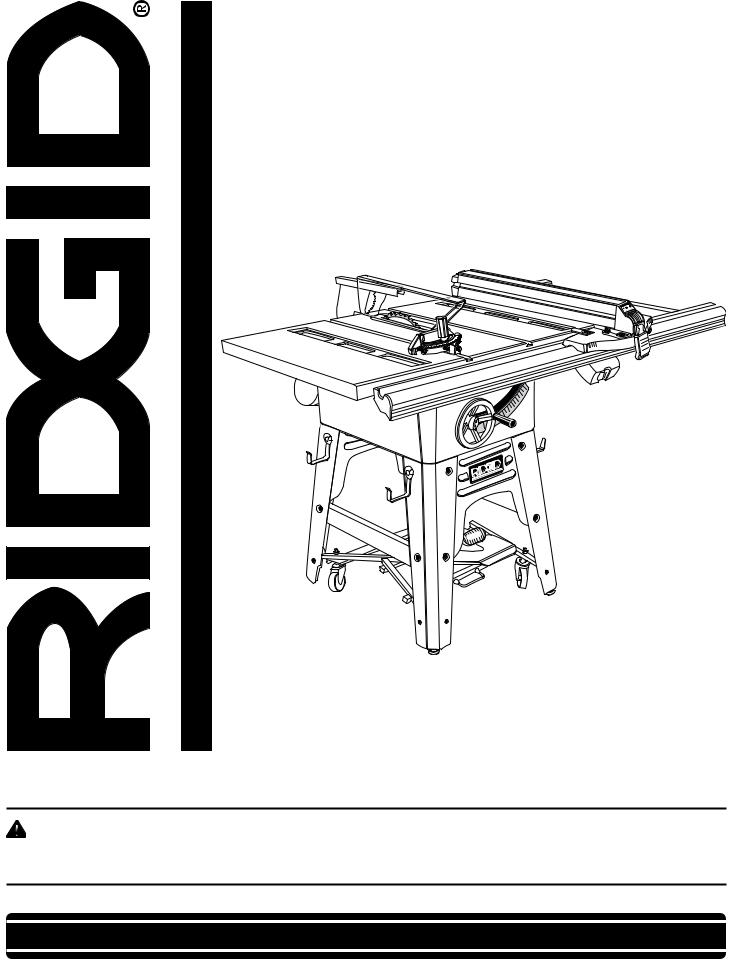
OPERATOR’S MANUAL
10 in. CAST IRON TABLE SAW
TS3650
Your new table saw has been engineered and manufactured to our high standards for dependability, ease of operation, and operator safety. When properly cared for, it will give you years of rugged, trouble-free performance.
WARNING:
To reduce the risk of injury, the user must read and understand the operator’s manual before using this product.
Thank you for buying a RIDGID product.
SAVE THIS MANUAL FOR FUTURE REFERENCE

TABLE OF CONTENTS |
|
n Introduction ...................................................................................................................................................................... |
2 |
n General Safety Rules..................................................................................................................................................... |
3-4 |
n Specific Safety Rules..................................................................................................................................................... |
4-5 |
n Symbols......................................................................................................................................................................... |
6-7 |
n Electrical ...................................................................................................................................................................... |
8-10 |
n Glossary of Terms........................................................................................................................................................... |
11 |
n Features..................................................................................................................................................................... |
12-13 |
n Tools Needed ................................................................................................................................................................. |
14 |
n Loose Parts................................................................................................................................................................ |
15-16 |
n Assembly ................................................................................................................................................................... |
17-27 |
n Operation................................................................................................................................................................... |
28-39 |
n Adjustments............................................................................................................................................................... |
40-46 |
n Maintenance................................................................................................................................................................... |
47 |
n Accessories .................................................................................................................................................................... |
47 |
n Troubleshooting......................................................................................................................................................... |
48-49 |
n Warranty ......................................................................................................................................................................... |
51 |
n Parts Ordering/Service ................................................................................................................................................... |
52 |
INTRODUCTION |
|
This tool has many features for making the use of this product more pleasant and enjoyable. Safety, performance, and dependability have been given top priority in the design of this product making it easy to maintain and operate.
2

GENERAL SAFETY RULES
WARNING:
Read and understand all instructions. Failure to follow all instructions listed below, may result in electric shock, fire and/or serious personal injury.
READ ALL INSTRUCTIONS
n KNOW YOUR POWER TOOL. Read the operator's manual carefully. Learn the tool’s applications and limitations as well as the specific potential hazards related to this tool.
n GUARD AGAINST ELECTRICAL SHOCK BY PREVENTING BODY CONTACT WITH GROUNDED SURFACES. For example: pipes, radiators, ranges, refrigerator enclosures.
nKEEP GUARDS IN PLACE and in working order. Never operate the tool with any guard or cover removed. Make sure all guards are operating properly before each use.
nREMOVE ADJUSTING KEYS AND WRENCHES.
Form habit of checking to see that keys and adjusting wrenches are removed from tool before turning it on.
nKEEP WORK AREA CLEAN. Cluttered areas and benches invite accidents. DO NOT leave tools or pieces of wood on the saw while it is in operation.
nAVOID DANGEROUS ENVIRONMENT. Don't use power tools in damp or wet locations or expose to rain. Keep work area well lit.
nKEEP CHILDREN AND VISITORS AWAY. All visitors should wear safety glasses and be kept a safe distance from work area. Do not let visitors contact tool or extension cord while operating.
nMAKE WORKSHOP CHILDPROOF with padlocks or master switches, or by removing starter keys.
nDON'T FORCE TOOL. It will do the job better and safer at the feed rate for which it was designed.
nUSE RIGHT TOOL. Don't force tool or attachment to do a job it was not designed for. Don't use it for a purpose not intended.
nMAKE SURE YOUR EXTENSION CORD IS IN GOOD CONDITION. When using an extension cord, be sure to use one heavy enough to carry the current your product will draw. An undersized cord will cause a drop in line voltage resulting in loss of power and overheating. A wire gauge size (A.W.G.) of at least 14 is recommended for an extension cord 25 feet or less in length. If in doubt, use the next heavier gauge. The smaller the gauge number, the heavier the cord.
nDRESSPROPERLY.Donotwearlooseclothing,gloves, neckties, or jewelry. They can get caught and draw you intomovingparts.Rubberglovesandnonskidfootwear are recommended when working outdoors. Also wear protective hair covering to contain long hair.
nALWAYS WEAR SAFETY GLASSES WITH SIDE SHIELDS. Everyday eyeglasses have only impactresistant lenses; they are NOT safety glasses.
nSECURE WORK. Use clamps or a vise to hold work when practical. It's safer than using your hand and frees both hands to operate tool.
nDON'TOVERREACH. Keepproperfootingandbalance at all times.
nMAINTAIN TOOLS WITH CARE. Keep tools sharp and clean for better and safer performance. Follow instructions for lubricating and changing accessories.
nDISCONNECT TOOLS. When not in use, before servicing, or when changing attachments, blades, bits, cutters, etc., all tools should be disconnected.
nAVOID ACCIDENTAL STARTING. Be sure switch is off when plugging in.
nUSE RECOMMENDED ACCESSORIES. The use of improper accessories may cause risk of injury.
nNEVER STAND ON TOOL. Serious injury could occur if the tool is tipped or if the cutting tool is unintentionally contacted.
nCHECK DAMAGED PARTS. Before further use of the tool, a guard or other part that is damaged should be carefully checked to determine that it will operate properly and perform its intended function. Check for alignment of moving parts, binding of moving parts, breakage of parts, mounting and any other conditions that may affect its operation. A guard or other part that is damaged must be properly repaired or replaced by an authorized service center to avoid risk of personal injury.
nUSE THE RIGHT DIRECTION OF FEED. Feed work into a blade or cutter against the direction of rotation of blade or cutter only.
nNEVER LEAVE TOOL RUNNING UNATTENDED. TURN POWER OFF. Don't leave tool until it comes to a complete stop.
nPROTECT YOUR LUNGS. Wear a face or dust mask if the cutting operation is dusty.
nPROTECT YOUR HEARING. Wear hearing protection during extended periods of operation.
nDON'T ABUSE CORD. Never yank cord to disconnect from receptacle. Keep cord from heat, oil, and sharp edges.
3

GENERAL SAFETY RULES
nUSE OUTDOOR EXTENSION CORDS. When tool is used outdoors, use only extension cords with approved ground connection that are intended for use outdoors and so marked.
nKEEP BLADES CLEAN AND SHARP. Sharp blades minimize stalling and kickback.
nBLADES COAST AFTER TURN OFF.
nNEVER USE IN AN EXPLOSIVE ATMOSPHERE.
Normal sparking of the motor could ignite fumes.
nINSPECT TOOL CORDS PERIODICALLY. Ifdamaged, have repaired by a qualified service technician at an authorizedservicefacility.Theconductorwithinsulation having an outer surface that is green with or without yellow stripes is the equipment-grounding conductor. If repair or replacement of the electric cord or plug is necessary, do not connect the equipment-grounding conductor to a live terminal. Repair or replace a damaged or worn cord immediately. Stay constantly aware of cord location and keep it well away from the rotating blade.
nINSPECT EXTENSION CORDS PERIODICALLY and replace if damaged.
nKEEP TOOL DRY, CLEAN, AND FREE FROM OIL AND GREASE. Always use a clean cloth when cleaning. Never use brake fluids, gasoline, petroleum-based products, or any solvents to clean tool.
nSTAY ALERT AND EXERCISE CONTROL. Watch what you are doing and use common sense. Do not operate tool when you are tired. Do not rush.
nDO NOT USE TOOL IF SWITCH DOES NOT TURN IT ON AND OFF. Have defective switches replaced by an authorized service center.
nUSE ONLY CORRECT BLADES. Do not use blades with incorrect size holes. Never use blade washers or bolts that are defective or incorrect. The maximum blade capacity of your saw is 10 in. (254 mm).
n BEFORE MAKING A CUT, BE SURE ALL ADJUSTMENTS ARE SECURE.
nAVOID CUTTING NAILS. Inspect for and remove all nails from lumber before cutting.
nNEVER TOUCH BLADE or other moving parts during use.
nNEVER START A TOOL WHEN ANY ROTATING COMPONENT IS IN CONTACT WITH THE WORKPIECE.
nDO NOT OPERATE THIS TOOL WHILE UNDER THE INFLUENCE OF DRUGS, ALCOHOL, OR ANY MEDICATION.
nGROUND ALL TOOLS. If tool is equipped with threeprong plug, it should be plugged into a three-hole electrical receptacle.
nWHEN SERVICING use only identical replacement parts. Use of any other parts may create a hazard or cause product damage.
nCHECK WITH A QUALIFIED ELECTRICIAN or service personnel if the grounding instructions are not completely understood or if in doubt as to whether the tool is properly grounded.
nDO NOT MODIFY the plug provided. If it will not fit the outlet, have the proper outlet installed by a qualified electrician.
nUSE ONLY RECOMMENDED ACCESSORIES listed in this manual or addendums. Use of accessories that are not listed may cause the risk of personal injury. Instructions for safe use of accessories are included with the accessory.
nDOUBLE CHECK ALL SETUPS. Make sure blade is tight and not making contact with saw or workpiece before connecting to power supply.
nMAKE SURE THE WORK AREA HAS AMPLE LIGHTING to see the work and that no obstructions will interfere with safe operation BEFORE performing any work using the table saw.
SPECIFIC SAFETY RULES
nALWAYS KEEP THE BLADE GUARD AND SPREADER (SPLITTER) IN PLACE and in working order.
nKEEP HANDS AWAY FROM CUTTING AREA. Keep hands away from blades. Do not reach underneath work or around or over the blade while blade is rotating. Do not attempt to remove cut material when blade is moving.
nGUARD AGAINST KICKBACK. Kickback occurs when the blade stalls rapidly and workpiece is driven back towards the operator. It can pull your hand into the blade resulting in serious personal injury. Stay out of blade path and turn switch off immediately if blade binds or stalls.
nUSE RIP FENCE. Always use a fence or straight edge guide when ripping.
4

SPECIFIC SAFETY RULES
nSUPPORT LARGE PANELS. To minimize risk of blade pinching and kickback, always support large panels.
nREMOVE ALL FENCES AND AUXILIARY TABLES before transporting saw. Failure to do so can result in an accident causing possible serious personal injury.
nALWAYS USE BLADE GUARD, SPREADER, AND ANTI-KICKBACK PAWLS on all "through-sawing" operations. Through-sawing operations are those in which the blade cuts completely through the workpiece as in ripping or crosscutting. Keep the blade guard down, the anti-kickback pawls down, and the spreader in place over the blade.
nALWAYS SECURE WORK firmly against rip fence or miter fence.
nALWAYS USE A PUSH STICK FOR RIPPING NARROW STOCK. A push stick is a device used to push a workpiece through the blade instead of using your hands. Size and shape can vary but the push stick must always be narrower than the workpiece to prevent the push stick from contacting the saw blade. When ripping narrow stock, always use a push stick, so your hand does not come close to the saw blade. Use a featherboard and push blocks for non-through cuts.
nNEVER perform any operation "freehand" which means using only your hands to support or guide the workpiece. Always use either the rip fence or miter fence to position and guide the work.
nNEVER stand or have any part of your body in line with the path of the saw blade.
nNEVER reach behind, over, or within three inches of the blade or cutter with either hand for any reason.
nMOVE THE RIP FENCE out of the way when crosscutting.
nNEVER use rip fence as cutoff gauge when crosscutting.
nNEVER attempt to free a stalled saw blade without first turning the saw OFF and disconnecting the saw from the power source.
nAVOID KICKBACKS (work thrown back toward you) by:
A.Keeping blade sharp.
B.Keeping rip fence parallel to the saw blade.
C.Keeping spreader, anti-kickback pawls, and blade guard in place and operating.
D.Not releasing the work before it is pushed all the way past the saw blade using a push stick.
E.Not ripping work that is twisted or warped or does not have a straight edge to guide along the fence.
nPROVIDE ADEQUATE SUPPORT to the rear and sides of the saw table for wide or long workpieces. Use a sturdy "outrigger" support if a table extension more than 24 inches long is attached to the saw.
nAVOID AWKWARD OPERATIONS AND HAND POSITIONS where a sudden slip could cause your hand to move into the cutting tool.
nALWAYS TURN OFF SAW before disconnecting it, to avoid accidental starting when reconnecting to power supply.
nSAVE THESE INSTRUCTIONS. Refer to them frequently and use to instruct other users. If you loan someone this tool, loan them these instructions also.
WARNING:
Some dust created by power sanding, sawing, grinding, drilling, and other construction activities contains chemicals known to cause cancer, birth defects or other reproductive harm. Some examples of these chemicals are:
•lead from lead-based paints,
•crystalline silica from bricks and cement and other masonry products, and
•arsenic and chromium from chemically-treated lumber.
Your risk from these exposures varies, depending on how often you do this type of work. To reduce your exposure to these chemicals: work in a well ventilated area, and work with approved safety equipment, such as those dust masks that are specially designed to filter out microscopic particles.
5
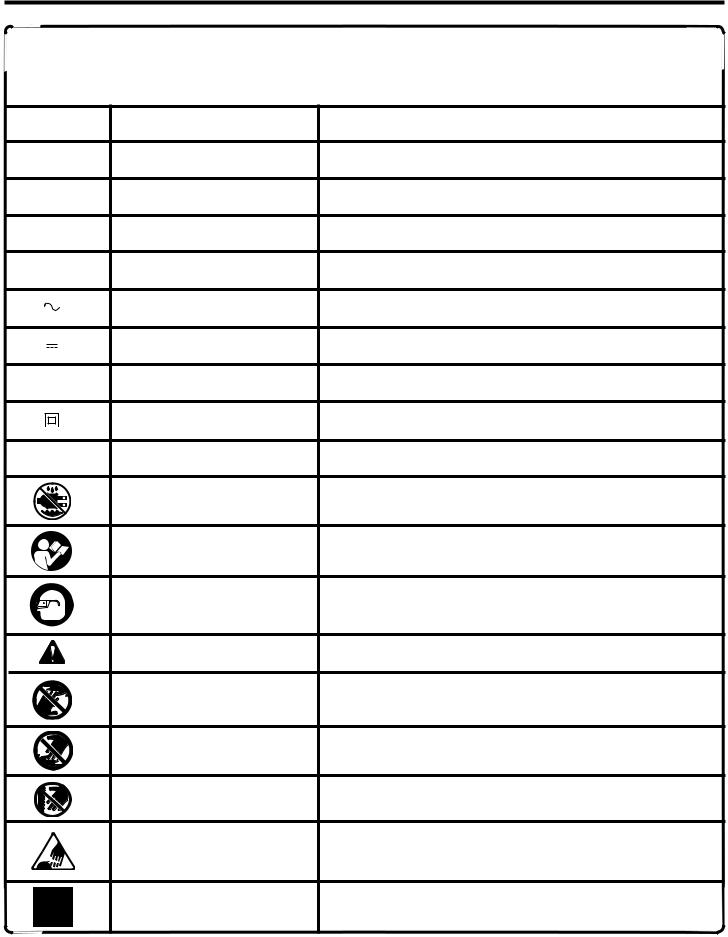
SYMBOLS
Some of the following symbols may be used on this tool. Please study them and learn their meaning. Proper interpretation of these symbols will allow you to operate the tool better and safer.
SYMBOL |
NAME |
DESIGNATION/EXPLANATION |
V |
Volts |
Voltage |
A |
Amperes |
Current |
Hz |
Hertz |
Frequency (cycles per second) |
W |
Watt |
Power |
min |
Minutes |
Time |
|
Alternating Current |
Type of current |
|
Direct Current |
Type or a characteristic of current |
no |
No Load Speed |
Rotational speed, at no load |
|
Class II Construction |
Double-insulated construction |
.../min |
Per Minute |
Revolutions, strokes, surface speed, orbits etc., per minute |
|
Wet Conditions Alert |
Do not expose to rain or use in damp locations. |
|
Read The Operator’s Manual |
To reduce the risk of injury, user must read and understand |
|
operator’s manual before using this product. |
|
|
|
|
|
Eye Protection |
Always wear safety goggles or safety glasses with side shields |
|
and a full face shield when operating this product. |
|
|
|
|
|
Safety Alert |
Precautions that involve your safety. |
|
No Hands Symbol |
Failure to keep your hands away from the blade will result in |
|
serious personal injury. |
|
|
|
|
|
No Hands Symbol |
Failure to keep your hands away from the blade will result in |
|
serious personal injury. |
|
|
|
|
|
No Hands Symbol |
Failure to keep your hands away from the blade will result in |
|
serious personal injury. |
|
|
|
|
|
No Hands Symbol |
Failure to keep your hands away from the blade will result in |
|
|
serious personal injury. |
|
Hot Surface |
To reduce the risk of injury or damage, avoid contact with |
|
any hot surface. |
|
|
|
6

SYMBOLS
The following signal words and meanings are intended to explain the levels of risk associated with this product.
SYMBOL |
SIGNAL |
MEANING |
|
|
DANGER: |
Indicates an imminently hazardous situation, which, if not avoided, will |
|
|
result in death or serious injury. |
||
|
|
||
|
|
|
|
|
WARNING: |
Indicates a potentially hazardous situation, which, if not avoided, could |
|
|
result in death or serious injury. |
||
|
|
||
|
|
|
|
|
CAUTION: |
Indicates a potentially hazardous situation, which, if not avoided, may |
|
|
result in minor or moderate injury. |
||
|
|
||
|
|
|
|
|
CAUTION: |
(Without Safety Alert Symbol) Indicates a situation that may result in |
|
|
property damage. |
||
|
|
||
SERVICE
Servicing requires extreme care and knowledge and should be performed only by a qualified service technician. For service we suggest you return the product to your nearest
AUTHORIZED SERVICE CENTER for repair. When servicing, use only identical replacement parts.
WARNING:
To avoid serious personal injury, do not attempt to use this product until you read thoroughly and understand completely the operator’s manual. Save this operator’s manual and review frequently for continuing safe operation and instructing others who may use this product.
 WARNING:
WARNING:
The operation of any power tool can result in foreign objects being thrown into your eyes, which can result in severe eye damage. Before beginning power tool operation, always wear safety goggles or safety glasses with side shields and a full face shield when needed. We recommend Wide Vision Safety Mask for use over eyeglasses or standard safety glasses with side shields. Always use eye protection which is marked to comply with ANSI Z87.1.
SAVE THESE INSTRUCTIONS
7
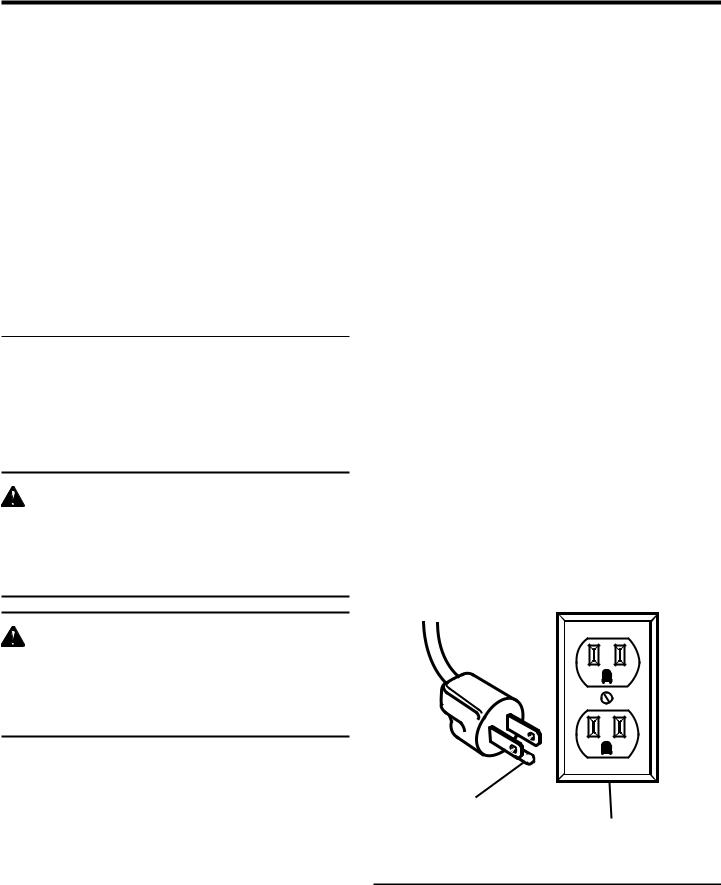
ELECTRICAL
EXTENSION CORDS
Use only 3-wire extension cords that have 3-prong grounding plugs and 3-pole receptacles that accept the tool's plug. Whenusingapowertoolataconsiderabledistancefromthe power source, use an extension cord heavy enough to carry the current that the tool will draw. An undersized extension cord will cause a drop in line voltage, resulting in a loss of power and causing the motor to overheat. Use the chart providedbelowtodeterminetheminimumwiresizerequired in an extension cord. Only round jacketed cords listed by Underwriter's Laboratories (UL) should be used.
**Ampere rating (on tool faceplate)
|
0-2.0 |
2.1-3.4 |
3.5-5.0 |
5.1-7.0 7.1-12.0 |
12.1-16.0 |
|
Cord Length |
Wire Size (A.W.G.) |
|
|
|||
|
|
|
|
|
|
|
25' |
16 |
16 |
16 |
16 |
14 |
14 |
|
|
|
|
|
|
|
50' |
16 |
16 |
16 |
14 |
14 |
12 |
|
|
|
|
|
|
|
100' |
16 |
16 |
14 |
12 |
10 |
— |
**Used on 12 gauge - 20 amp circuit.
NOTE: AWG = American Wire Gauge
When working with the tool outdoors, use an extension cord that is designed for outside use. This is indicated by the letters “WA” on the cord’s jacket.
Before using an extension cord, inspect it for loose or exposed wires and cut or worn insulation.
WARNING:
Keep the extension cord clear of the working area. Position the cord so that it will not get caught on lumber, tools or other obstructions while you are working with a power tool. Failure to do so can result in serious personal injury.
SPEED AND WIRING
The no-load speed of this tool is approximately 3450 rpm. This speed is not constant and decreases under a load or with lower voltage. For voltage, the wiring in a shop is as important as the motor’s horsepower rating. A line intended only forlights cannot properly carry a powertoolmotor. Wire that is heavy enough for a short distance will be too light for a greater distance. A line that can support one power tool may not be able to support two or three tools.
GROUNDING INSTRUCTIONS
In the event of a malfunction or breakdown, grounding provides a path of least resistance for electric current to reduce the risk of electric shock. This tool is equipped with an electric cord having an equipment-grounding conductor and a grounding plug. The plug must be plugged intoamatchingoutletthatisproperlyinstalledandgrounded in accordance with all local codes and ordinances.
Do not modify the plug provided. If it will not fit the outlet, have the proper outlet installed by a qualified electrician. Improperconnectionoftheequipment-groundingconductor can result in a risk of electric shock. The conductor with insulation having an outer surface that is green with or without yellow stripes is the equipment-grounding conductor. If repair or replacement of the electric cord or plug is necessary, do not connect the equipment-grounding conductor to a live terminal.
Check with a qualified electrician or service personnel if the grounding instructions are not completely understood, or if in doubt as to whether the tool is properly grounded.
Repair or replace a damaged or worn cord immediately.
This tool is intended for use on a circuit that has an outlet like the one shown in figure 1. It also has a grounding pin like the one shown.
WARNING:
Check extension cords before each use. If damaged replace immediately. Never use tool with a damaged cord since touching the damaged area could cause electrical shock resulting in serious injury.
ELECTRICAL CONNECTION
This tool is powered by a precision built electric motor. It should be connected to a power supply that is 120 volts, 60Hz,AConly(normalhouseholdcurrent).Donotoperate this tool on direct current (DC). A substantial voltage drop will cause a loss of power and the motor will overheat. If the saw does not operate when plugged into an outlet, double check the power supply.
GROUNDING
PIN COVER OF GROUNDED OUTLET BOX
Fig. 1
8
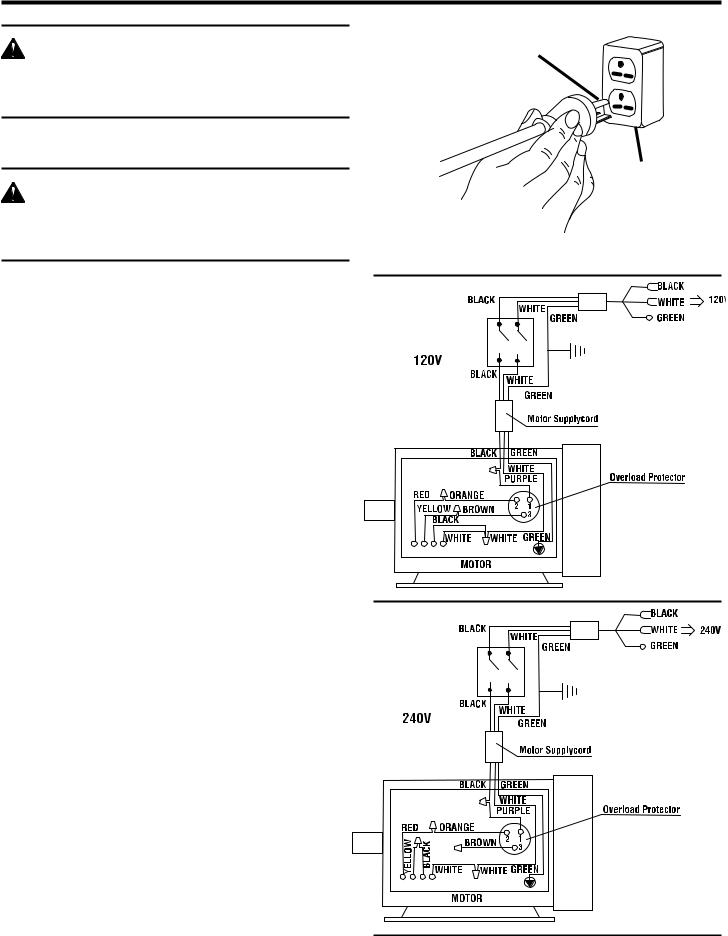
ELECTRICAL
WARNING:
To prevent possible electrical hazards, have a qualified electrician check the line if you are not certain that it is properly wired.
CHANGING MOTOR VOLTAGE
See Figures 2 - 4.
WARNING:
Electric shock can kill. To reduce the risk of serious personal injury, never connect plug to power source until all assembly steps are completed.
NOTE: The table saw is prewired at the factory for 120 volts, 60Hz.Usethefollowingprocedurestochangemotorvoltage from 120 volts to 240 volts.
nUnplug the saw.
nLocated on the top of the motor is the junction box. Remove the phillips screw at the back of the junction box then lift off the cover.
nRemove and discard the electrical tape from the wire connectors. Remove wire connectors.
nReconnect the leads.
nReinstall the wire connectors and wrap each wire with two layers of new UL listed electrical tape.
nRecheck your wiring with the wiring diagrams.
nReinstall the junction box cover using the phillips screw.
nCut off the 120 volt power cord plug and replace it with a 3-prong 240 volt, 15 amp. UL listed plug.
nConnect the power cord white and black leads, respectively, to the "hot" plug blade terminals. Connect the power cord green grounding wire to the plug ground prong terminal.
nPlug your table saw into a 220-240 volt, 15 amp., 3-prong receptacle. Make certain the receptacle is connected to a 240 volt, AC power supply through a 240 volt branch circuit having at least a 15 amp capacity and protected by a 15 amp time-delay fuse or circuit breaker.
GROUNDING
PIN
COVER OF GROUNDED
OUTLET BOX
FOR USE WITH 220-240 VOLT |
Fig. 2 |
|
Fig. 3
Fig. 4
9
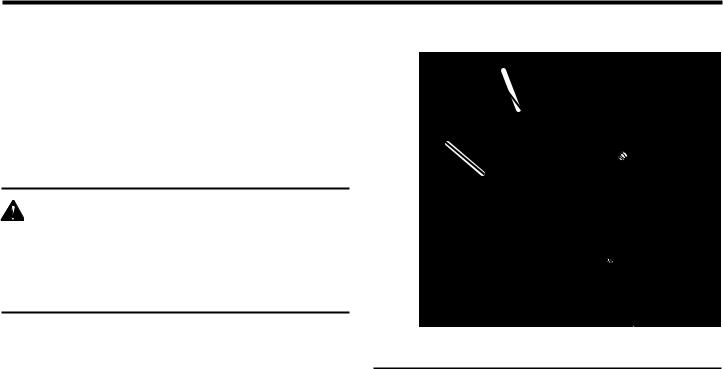
ELECTRICAL
MOTOR THERMAL OVERLOAD PROTECTOR
See Figure 5.
Yourtablesawcomesequippedwithamanual-resetthermal- overload protector designed to open the power line circuit whenthemotortemperatureexceedsasafelevel,whenmotor is overloaded, or when a low voltage condition exists.
NOTE: This motor should be blown out or vacuumed frequently to prevent sawdust buildup which can interfer with normal motor ventilation.
WARNING:
To reduce the risk of serious personal injury from thrown objects or blade contact from unexpected starting, immediately turn off the table saw if the protector stops the table saw motor. Remove the switch key and allow the motor time to cool.
nOncethemotoriscooledtoasafeoperatingtemperature, reset the thermal overload protector by pushing the red button on the front of the junction box. An audible click will indicate the thermal overload protector is reset. Once the button is reset, the table saw may be started and operated as normal.
NOTE:Iftheredbuttonwon'tclickintoplaceimmediately, the motor is still too hot and must be allowed to cool.
Frequent “blowing” of fuses or tripping of circuit breakers may result if:
nMotorisoverloaded.Overloadingcanoccurifaworkpiece is fed too rapidly or if the table saw is misaligned.
nMotor circuit is fused differently from recommendations. Always follow instructions for the proper fuse/breaker. Do not use a fuse/breaker of greater capacity without consulting a qualified electrician.
nLowvoltage.Althoughthemotorisdesignedforoperation on the voltage and frequency specified on the motor, normal loads will be handled safely on voltage no more than ten percent above or below that figure. Heavy loads, however,requirethatvoltageatmotorterminalsequalthe voltage specified on the motor.
NOTE:Alwayschecktheconnections,theloadandthesupply circuit whenever the motor fails to perform satisfactorily.
JUNCTION
BOX
MANUAL RESET
BUTTON
Fig. 5
10

GLOSSARY OF TERMS
Anti-Kickback Pawls (radial arm and table saws)
A device which, when properly installed and maintained, is designed to stop the workpiece from being kicked back toward the front of the saw during a ripping operation.
Arbor
The shaft on which a blade or cutting tool is mounted.
Bevel Cut
A cutting operation made with the blade at any angle other than 90° to the table surface.
Chamfer
A cut removing a wedge from a block so the end (or part of the end) is angled rather than at 90°.
Compound Cut
A cross cut made with both a miter and a bevel angle.
Crosscut
A cutting or shaping operation made across the grain or the width of the workpiece.
Cutter Head (planers and jointers)
A rotating piece of adjustable blades. The cutter head removes material from the workpiece.
Dado Cut
A non-through cut which produces a square-sided notch or trough in the workpiece (requires a special blade).
Featherboard
A device used to help control the workpiece by guiding it securely against the table or fence during any ripping operation.
FPM or SPM
Feet per minute (or strokes per minute), used in reference to blade movement.
Freehand
Performing a cut without the workpiece being guided by a fence, miter gauge, or other aids.
Gum
A sticky, sap-based residue from wood products.
Heel
Alignment of the blade to the fence.
Kerf
The material removed by the blade in a through cut or the slot produced by the blade in a non-through or partial cut.
Kickback
A hazard that can occur when the blade binds or stalls, throwing the workpiece back toward operator.
Leading End
The end of the workpiece pushed into the tool first.
Miter Cut
A cutting operation made with the workpiece at any angle to the blade other than 90°.
Non-Through Cuts
Any cutting operation where the blade does not extend completely through the thickness of the workpiece.
Push Blocks and Push Sticks
Devices used to feed the workpiece through the saw blade during cutting operations. A push stick (not a push block) should be used for narrow ripping operations. These aids help keep the operator's hands well away from the blade.
Pilot Hole (drill presses)
A small hole drilled in a workpiece that serves as a guide for drilling large holes accurately.
Resaw
Acuttingoperationtoreducethethicknessofthework-piece to make thinner pieces.
Resin
A sticky, sap-based substance that has hardened.
Revolutions Per Minute (RPM)
The number of turns completed by a spinning object in one minute.
Ripping or Rip Cut
A cutting operation along the length of the workpiece.
Riving Knife (table saws)
Also known as a spreader or splitter. A metal piece, slightly thinner than the saw blade, which helps keep the kerf open and also helps to prevent kickback.
Saw Blade Path
The area over, under, behind, or in front of the blade. As it applies to the workpiece, that area which will be or has been cut by the blade.
Set
The distance that the tip of the saw blade tooth is bent (or set) outward from the face of the blade.
Snipe (planers)
Depression made at either end of a workpiece by cutter blades when the workpiece is not properly supported.
Throw-Back
The throwing back of a workpiece usually caused by the workpiece being dropped into the blade or being placed inadvertently in contact with the blade.
Through Sawing
Any cutting operation where the blade extends completely through the thickness of the workpiece.
Workpiece or Material
The item on which the operation is being done.
Worktable
Surface where the workpiece rests while performing a cutting, drilling, planing, or sanding operation.
11
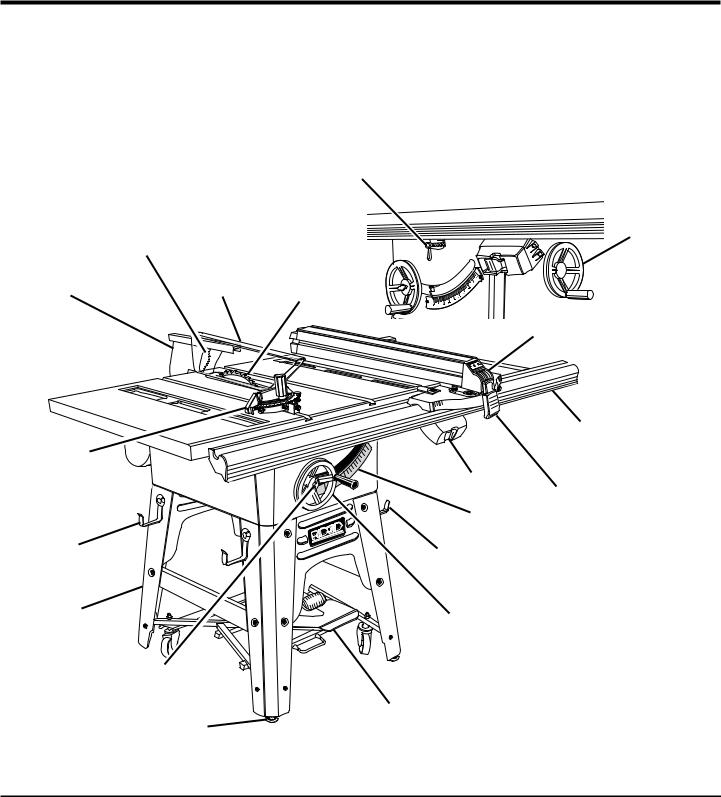
FEATURES
PRODUCT SPECIFICATIONS
Blade Diameter........................................... |
10 in. (254 mm) |
Blade Arbor ................................................ |
5/8 in. (16 mm) |
Cutting Depth at 0°............................... |
3-3/8 in. (85.7 mm) |
Cutting Depth at 45°........................... |
2-1/4 in. (57.15 mm) |
Rating................... |
120 Volts, 60 Hz, AC Only, 13 |
Amperes |
|
240 Volts, 60 Hz, AC Only, 6.5 |
Amperes |
Output Speed..................................................... |
3,450/min. |
|
Net Weight............................................... |
287 lbs. (130 kg.) |
|
|
|
BEVEL LOCK LEVER |
|
|
ANTI-KICKBACK |
|
BEVEL ADJUSTING |
|
|
HANDWHEEL |
|
|
PAWLS |
|
|
|
|
|
|
SEPARATOR |
BLADE GUARD |
SAW |
|
(SPLITTER) |
ASSEMBLY |
|
|
BLADE |
|
||
|
|
|
|
|
|
|
RIP FENCE |
|
|
|
FRONT |
MITER GAUGE |
|
|
RAIL |
|
|
|
|
|
|
SWITCH |
LOCKING |
|
|
|
|
|
|
BEVEL |
LEVER |
|
|
|
|
RIP FENCE |
|
SCALE |
|
STORAGE |
|
MITER GAUGE |
|
HOOKS |
|
|
|
|
|
STORAGE HOOKS |
|
LEG STAND |
|
HEIGHT |
|
|
|
|
|
|
|
ADJUSTING |
|
|
|
HANDWHEEL |
|
BLADE HEIGHT
LOCK KNOB
LEVELING |
HERC-U-LIFT™ |
|
MOBILE BASE |
||
FOOT |
||
|
Fig. 6
12

FEATURES
KNOW YOUR TABLE SAW
See Figure 6.
Before attempting to use this product, familiarize yourself with all operating features and safety rules.
OVERVIEW
The upper portion of the blade projects up through the table, surrounded by an insert called the throat plate. The height of the blade is set with a height adjusting handwheel on the front of the cabinet. Detailed instructions are provided in the Operation section of this manual for the basic cuts: rip cuts, cross cuts, miter cuts, bevel cuts, and compound cuts.
For cuts with the blade straight up and cutting across the grain (cross cuts or miter cuts), use the miter gauge to set the angle and push the wood into the blade. To cut with the blade straight up, along the grain of the wood (rip cuts), use the rip fence to guide the wood. Push smaller pieces with a push block or push stick.
To tilt the blade for a bevel cut, use the bevel adjusting handwheel on the side of the cabinet. A bevel scale on the front of the cabinet shows the blade angle. Inside the cabinet, adjustable positive stops control the degree of tilt which can be adjusted with the screws in the top of the saw table. Use the miter gauge for a bevel cross cut (compound cut) and the rip fence for a bevel rip cut.
Your saw is designed to perform as a versatile, accurate, precision cutting tool that is easy to operate. It is equipped withthefollowingfeaturesforconvenience,easeofuse,and high-quality performance:
ANTI-KICKBACKPAWLS-Kickbackisahazardinwhichthe workpiece is thrown back toward the operator. The toothed pawls are designed to snag the workpiece to prevent or reduce injury should kickback occur.
BEVEL ADJUSTING HANDWHEEL - Use this handwheel to set the angle of the blade for bevel cuts. It is located on the side of the cabinet.
BEVEL SCALE - The easy-to-read scale on the front of the workstand shows the exact blade angle.
BLADE - For maximum performance, it is recommended that you use the 40-tooth, 10 in. (254 mm) carbide tipped combination blade provided with your saw. Additional blade styles of the same high quality are available for specific operations such as ripping. Your local dealer can provide you with complete information.
WARNING:
Do not use blades rated less than the speed of this tool. Failure to heed this warning could result in personal injury.
BLADE GUARD - Always keep the guard down over the blade for through-sawing cuts.
BLADEHEIGHTLOCKKNOB-Thisknob,inthecenterofthe height adjusting handwheel, locks the handwheel into place and must be unlocked before turning the handwheel.
BEVEL LOCK LEVER - This lever, placed just under the worktablesurfaceonthefrontofthecabinet,lockstheangle setting of the blade. Be sure the lever is unlocked before tilting the blade. If it is not unlocked, it may jam and bend the locking bolt.
HEIGHT ADJUSTING HANDWHEEL - Use this handwheel tolowerandraisethebladeforadjustmentsorreplacement. It is located on the front of the cabinet.
HERC-U-LIFT MOBILE BASETM - This saw comes with a mobile base that allows for easy mobility.
IND-I-CUT™ ALIGNMENT DISC - Aplasticinsertonwhich marks may be made to indicate the location of the cut on the workpiece.
LOCKING LEVER - The lever on the front of the rip fence releases the rip fence or locks it in place.
MITER GAUGE - This miter gauge aligns the wood for a crosscut.Theeasy-to-readindicatorshowstheexactangle for a miter cut, with positive stops at 90° and 45°.
MITER GAUGE GROOVES - The miter gauge rides in these grooves on either side of the blade.
MOTOR-Thepowerfulinductionmotor,withcapacitorstart and poly V-belt drive, is housed in a sturdy steel base.
RAILS - Front and rear rails provide support for the rip fence and extension tables.
RIPFENCE-Asturdymetalfenceguidestheworkpieceand is secured with the locking lever. Grooves run along the top and sides of the rip fence for use with clamps and jigs.
SCALE - Found on the front rail, the easy-to-read scale provides precise measurements in rip cuts.
SEPARATOR OR SPLITTER - A metal piece, slightly thinner than the saw blade which helps keep the kerf open and prevent kickback.
SWITCH ASSEMBLY - Your table saw has an easy access power switch located below the front rail. The yellow switch key must be removed from the blister pack and inserted into the switch before the saw can be operated. To lock the switch in the OFF position, remove the switch key from the switch. Place the key in a location that is inaccessible to children and others not qualified to use the tool.
13
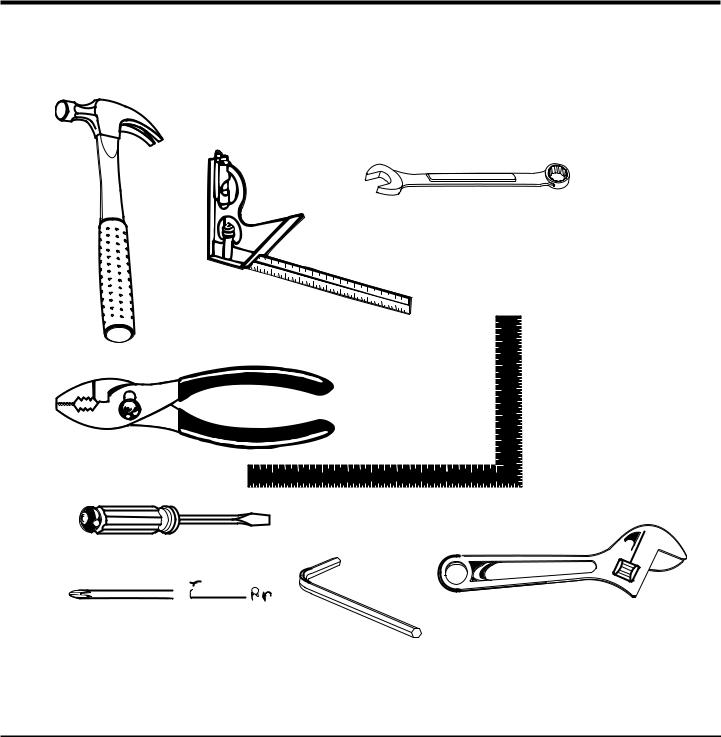
TOOLS NEEDED
The following tools (not included) are needed for assembly and alignment:
HAMMER
COMBINATION WRENCH (9) (10 mm, 11 mm, 12 mm, 13 mm, 14 mm,17 mm, 1/2 in., 9/16 in. 11/16 in.)
COMBINATION SQUARE
PLIERS
FRAMING SQUARE
SCREWDRIVER (2) (SMALL AND MEDIUM)

 ADJUSTABLE WRENCH PHILLIPS SCREWDRIVER
ADJUSTABLE WRENCH PHILLIPS SCREWDRIVER
HEX KEYS (4) (2.5 mm, 1/8 in., 5/32 in., 3/16 in.)
Fig. 7
14
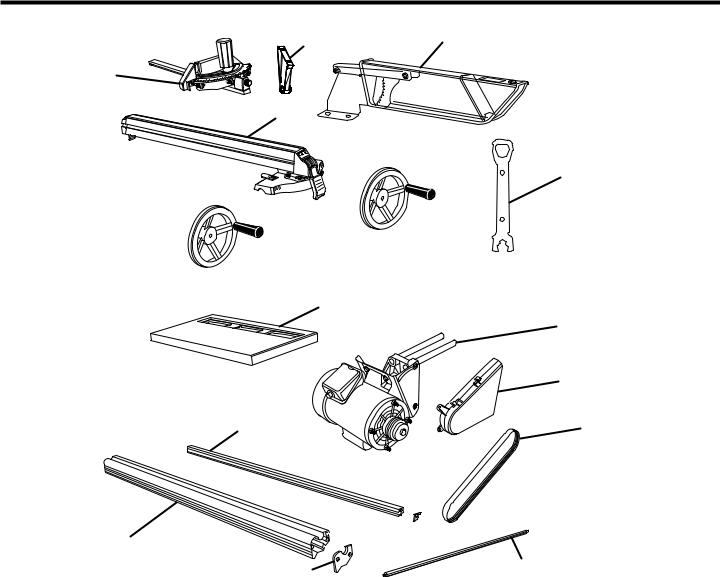
LOOSE PARTS LIST
23
1
5
6  4
4
7 
11
12
13
10 |
14 |
8 
|
9 |
|
|
|
|
|
16 |
|
|
15 |
|
|
|
|
|
|
Fig. 8 |
|
|
|
|
|
|
Key |
|
|
Key |
|
|
No. |
Description |
Qty. |
No. |
Description |
Qty. |
1 |
Miter Gauge ....................................................... |
1 |
10 |
Back Rail ............................................................ |
1 |
2 |
Guard Support Assembly................................... |
1 |
11 |
Table Extension................................................... |
2 |
3 |
Blade Guard Assembly....................................... |
1 |
12 |
Motor................................................................... |
1 |
4 |
Blade Wrench..................................................... |
2 |
13 |
Belt Guard........................................................... |
1 |
5 |
Rip Fence........................................................... |
1 |
14 |
Drive Belt............................................................. |
1 |
6 |
Bevel Adjusting Handwheel ............................... |
1 |
15 |
Spacer Bar .......................................................... |
1 |
7 |
Height Adjusting Handwheel.............................. |
1 |
16 |
Front End Cap (left and right).............................. |
2 |
8 |
Back End Cap (left and right)............................. |
2 |
17 |
Blister Hardware Pack |
|
9 |
Front Rail |
1 |
|
(contents noted on blister pack) - not shown...... |
1 |
|
|
|
15
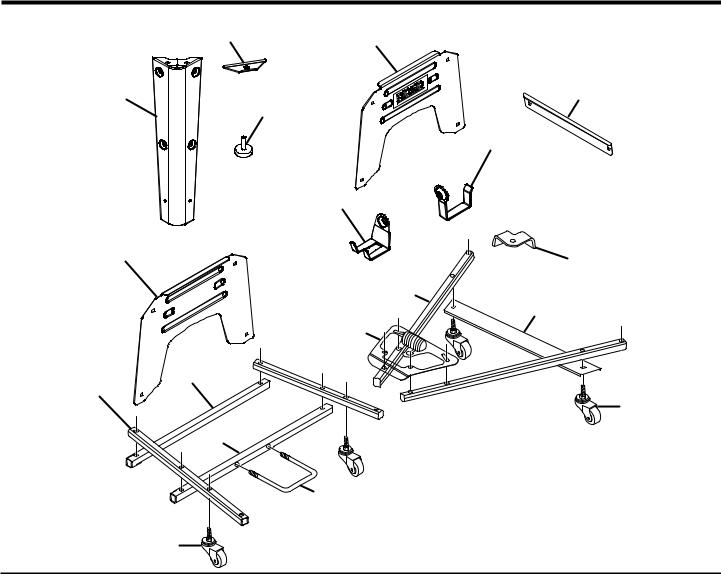
LOOSE PARTS LIST
62
1 |
4 |
5
11
|
12 |
3 |
10 |
|
|
|
7 |
|
13 |
|
14 |
|
17 |
8
|
|
9 |
|
16 |
|
|
15 |
|
|
9 |
Fig. 9 |
|
|
|
Key |
|
|
No. |
Description |
Qty. |
1 |
Leg ........................................................................................................................................................................ |
4 |
2 |
Front Brace ........................................................................................................................................................... |
1 |
3 |
Back Brace............................................................................................................................................................ |
1 |
4 |
Side Brace ............................................................................................................................................................ |
2 |
5 |
Leveling Feet......................................................................................................................................................... |
4 |
6 |
Foot Brace ............................................................................................................................................................ |
4 |
7 |
Rear Tube.............................................................................................................................................................. |
2 |
8 |
Front Tube............................................................................................................................................................. |
2 |
9 |
Swivel Caster ........................................................................................................................................................ |
4 |
10 |
Leg Bracket........................................................................................................................................................... |
4 |
11 |
Rip Fence Storage Hooks..................................................................................................................................... |
2 |
12 |
Miter Gauge Storage Hook................................................................................................................................... |
1 |
13 |
Center Brace......................................................................................................................................................... |
1 |
14 |
Unlock Pedal Assembly........................................................................................................................................ |
1 |
15 |
U-Bolt.................................................................................................................................................................... |
1 |
16 |
U-Bolt Tube........................................................................................................................................................... |
1 |
17 |
Tube Support ........................................................................................................................................................ |
1 |
18 |
Blister Hardware Pack, small (contents noted on blister pack) - not shown......................................................... |
1 |
19 |
Blister Hardware Pack, large (contents noted on blister pack) - not shown ......................................................... |
1 |
16
